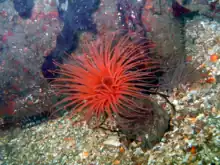| Pachycerianthus fimbriatus | |
|---|---|
 | |
| At Monterey Bay, CA, USA. | |
| Scientific classification | |
| Domain: | Eukaryota |
| Kingdom: | Animalia |
| Phylum: | Cnidaria |
| Subclass: | Ceriantharia |
| Order: | Spirularia |
| Family: | Cerianthidae |
| Genus: | Pachycerianthus |
| Species: | P. fimbriatus |
| Binomial name | |
| Pachycerianthus fimbriatus McMurrich, 1910[1] | |
| Synonyms | |
| |
Pachycerianthus fimbriatus is a cerianthid anemone that burrows in substrate and lives in a semi-rigid tube made of felted nematocysts. The anemone is often seen in bright orange to red.
Like most anemones, the tube-dwelling anemone contains stinging cells or nematocytes along its tentacles, however, the cells are not toxic to humans.
The ceriantharia possess two whorls of tentacles, one surrounding the mouth (labial tentacles) and one at the edge of the oral disc (marginal tentacles).
Distribution
This species was described from Indonesia. It is considered to be synonymous with Pachycerianthus plicatus which was described from the Pacific Ocean coast of North America.[2]
Biology
Pachycerianthus fimbriatus feeds on small crustaceans. The giant nudibranch Dendronotus iris has been documented to prey upon P. fimbriatus.
References
- ↑ McMurrich, J.P. (1910). Actiniaria of the Siboga expedition, Part I. Ceriantharia. Siboga-Expeditie. Monograph 15a:1-48 page(s): 35-38
- ↑ Molodtsova, T. (2015). Pachycerianthus fimbriatus. Accessed through: World Register of Marine Species on 2016-02-10.
2.[1]
External links
- Photos of Pachycerianthus fimbriatus on Sealife Collection
- ↑ Arai, Mary Needler (November 1985). "Electrical activity associated with withdrawal and feeding ofPachycerianthus fimbriatus(Anthozoa, Ceriantharia)". Marine Behaviour and Physiology. 12 (1): 47–56. doi:10.1080/10236248509378632. ISSN 0091-181X.